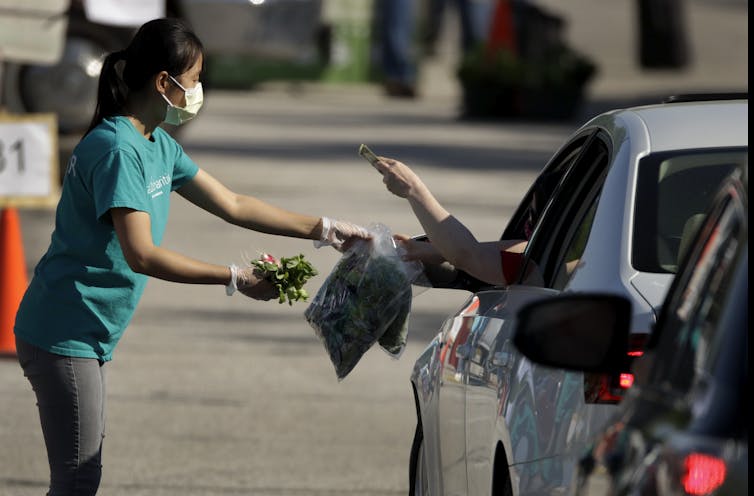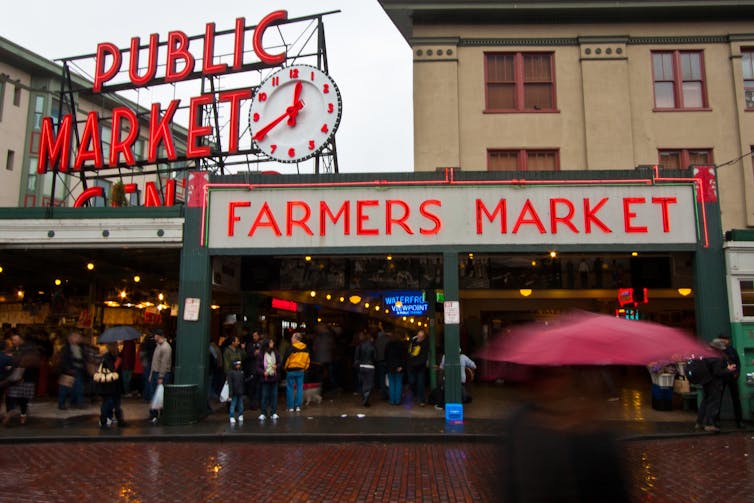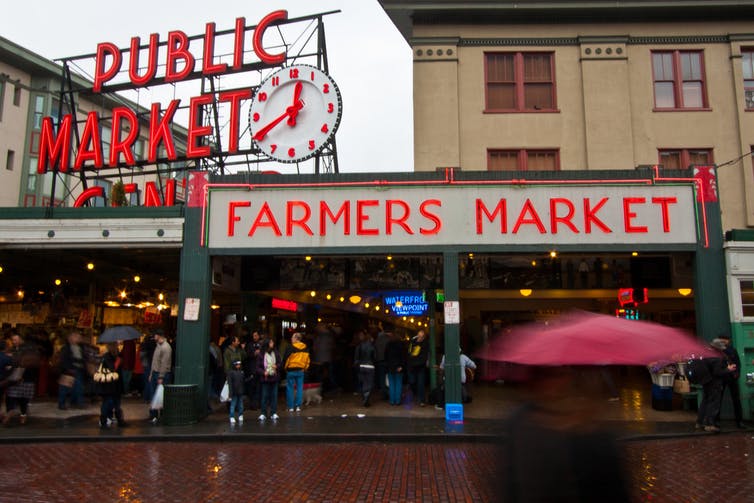Farmers markets are growing their role as essential sources of healthy food for rich and poor

AP Photo/Charlie Riedel
Edna Ledesma, University of Wisconsin-Madison and Alfonso Morales, University of Wisconsin-Madison
For many Americans, buying fresh local food at one of the estimated 9,000 farmers markets across the U.S. is one of summer’s pleasures. But farmers markets aren’t just nice amenities. Over the past 18 months, many have filled food supply gaps caused by COVID-19 shutdowns.
While numerous farmers markets shut down at the start of the pandemic, many soon reopened under state or local guidelines that mandated masks, social distancing and other precautions.
When grocery store supply chains were disrupted, consumer interest in local foods spiked, along with concerns about exposure to the coronavirus while shopping. Farmers market managers adapted swiftly, experimenting with options like prepackaged goods and drive-thru pickup.
In fact, many farmers markets enjoyed their strongest-ever sales in 2020. Affluent shoppers became more interested in buying local food, while lower-income buyers were able to use federal benefits like the Supplemental Nutrition Assistance Program. Stepping into this expanded role was no mean feat – but we know from our research in city planning and urban food systems that with adequate support, marketplaces respond vigorously to crises and opportunities.
The fall and rise of urban farmers markets
Farmers have been selling their goods at public markets in the U.S. for centuries. Many U.S. cities evicted or sidelined street vendors in the mid-20th century to make room for large-scale retail stores. But in the 1970s and ‘80s, farmers markets started reappearing in middle-class communities and suburbs.
This resurgence, which reflected the rise of the environmental movement, was most evident in university towns like Berkeley, California, and Madison, Wisconsin. In these communities, restaurants, farmers markets and educated consumers converged around the idea of eating locally produced food. Consumers wanted to taste flavors they remembered from childhood, and a new generation of growers were learning and practicing ecologically friendly farming methods.
At the same time, the U.S. Department of Agriculture became interested in the related phenomena of organic products and local foods sold directly to consumers. In the 1990s, the agency began to document the number of U.S. farmers markets.
Cities like Des Moines, Iowa, and San Antonio began to promote “placemaking” initiatives around markets, using them to help create quality public spaces. By the 2000s multifunctional markets became common, often serving racially and economically diverse populations.

ThreeIfByBike/Flickr, CC BY-SA
For example, by 2019 Chicago had 27 outdoor farmers markets across the city, offering goods such as clothing and furniture along with food. Some cities repurposed sites such as fairgrounds and drive-in theaters to house outdoor markets.
Governments began to view markets as policy tools for promoting
food security, fostering new farmers and supporting place-based community development. Advocacy organizations supporting farmers markets also emerged to help markets attract public and private support. In 2008 the Farmers Market Coalition, a California-based nonprofit, was launched to represent markets around the country.
Filling COVID gaps
The pandemic worsened food insecurity in the U.S., where it already was a serious concern. A lack of reliable access to healthy food contributes to many long-term health issues, and has severe implications for child development.
According to the nonprofit organization Feeding America, food insecurity in the U.S. rose dramatically because of the pandemic. In 2020, 45 million people – including 15 million children – experiencing food insecurity, up from 35 million in 2019.
Farmers markets have become important tools for reducing food insecurity over the past 15 years. Most studies that measure food access focus on two factors: households’ proximity to food sources and access to transportation. Food sources can include supermarkets, discount stores, convenience stores, farmers markets and food pantries. Among these options, consumers purchase healthy food mostly at supermarkets and farmers markets.
Federal funding distributed through the U.S. Department of Agriculture transformed food security during the COVID-19 pandemic. The Coronavirus Food Assistance Program took a variety of steps to move locally and regionally produced food into schools, food banks and farmers markets.
About US$19 billion went to these various outlets. Farmers markets helped to expand access to food, with most states declaring them to be essential services.
While there are no uniform national statistics, surveys and media reports show that many food-insecure people shopped at farmers markets during the pandemic. A survey by the Farmers Market Coalition found that in the summer of 2020, purchases using SNAP benefits – the largest federal food assistance program – increased over 2019 levels at nearly 40% of markets that responded. From central Texas to western North Carolina to Connecticut, farmers markets reported dramatic increases in customers using SNAP and Pandemic Electronic Benefits Transfer cards.
Farmers markets for the 21st century
As the pandemic showed, farmers markets make communities more resilient during catastrophic events. We are working to help markets become more effective and efficient so that they can play even larger roles in their communities.
We have developed a toolkit called Farm 2 Facts for market managers to help them collect and analyze economic, ecological and other data to address a wide range of questions. For example, markets have used the program to track visitor counts and demographic trends, conduct outreach to low-income and minority shoppers and estimate the markets’ local economic impacts.
We also are developing ecosystem metrics to help farmers and markets educate consumers about farmers markets’ important ecological benefits. This tool will enable farmers to measure how their products promote environmental goals such as biodiversity and soil health.
[Over 100,000 readers rely on The Conversation’s newsletter to understand the world. Sign up today.]Technology investments are helping farmers markets to grow. One priority is having the capability to process electronic benefits transactions so that the markets can serve customers at all income levels. And decision-support software like Farm 2 Facts can help them document how farmers markets promote health, equality and sustainability.
The next time you visit a farmers market, look past the corn and cucumbers. You’ll see an organization that’s promoting health and wellness, contributing to the local economy and bringing people together.
Edna Ledesma, Assistant Professor of Planning and Landscape Architecture, University of Wisconsin-Madison and Alfonso Morales, Vilas Distinguished Achievement Professor of Planning and Landscape Architecture, University of Wisconsin-Madison
This article is republished from The Conversation under a Creative Commons license. Read the original article.
Backyard Aquaponics Farming Fresh Fish and Vegetables
Relax in your garden – Ezz Jazz STREAMING NOW
Farmers markets are growing their role as essential sources of healthy food for rich and poor





Views: 4
1
0
Share This
Read Time:5 Minute, 46 Second
The Internet Archive has been fighting for 25 years to keep what’s on the web from disappearing – and you can help
The Internet Archive turns 25 years old help save itPeople are warned that what they post on the internet will live forever. But that’s not really the case.
3alexd/E+ via Getty Images
Kayla Harris, University of Dayton; Christina Beis, University of Dayton, and Stephanie Shreffler, University of Dayton
This year the Internet Archive turns 25. It’s best known for its pioneering role in archiving the internet through the Wayback Machine, which allows users to see how websites looked in the past.
Increasingly, much of daily life is conducted online. School, work, communication with friends and family, as well as news and images, are accessed through a variety of websites. Information that once was printed, physically mailed or kept in photo albums and notebooks may now be available only online. The COVID-19 pandemic has pushed even more interactions to the web.
You may not realize portions of the internet are constantly disappearing. As librarians and archivists, we strengthen collective memory by preserving materials that document the cultural heritage of society, including on the web. You can help us save the internet, too, as a citizen archivist.
Disappearing act
People and organizations remove content from the web for a variety of reasons. Sometimes it’s a result of changing internet culture, such as the recent shutdown of Yahoo Answers.
It can also be a result of following best practices for website design. When a website is updated, for example, the previous version is overwritten – unless it was archived.
Web archiving is the process of collecting, preserving and providing continued access to information on the internet. Often this work is done by librarians and archivists, with assistance from automated technology like web crawlers.
Web crawlers are programs that index web pages to make them available through search engines, or for long-term preservation. The Internet Archive, a nonprofit organization, uses thousands of computer servers to save multiple digital copies of these pages, requiring over 70 petabytes of data. It is funded through donations, grants and payments for its digitization services. Over 750 million web pages are captured per day in the Internet Archive’s Wayback Machine.
Why archive?
In 2018, President Donald Trump wrongly claimed via Twitter that Google had promoted on its homepage President Barack Obama’s State of the Union address, but not his own. Archived versions of the Google homepage proved that Google had, in fact, highlighted Trump’s State of the Union address in the same manner. Multiple news outlets use the Internet Archive’s Wayback Machine as the source for fact-checking these types of claims, since screenshots alone can be easily altered.
A 2019 report from the Tow Center for Digital Journalism examined the digital archiving practices and policies of newspapers, magazines and other news producers. The interviews revealed that many news media staff either do not have the resources to devote to archiving their work or misunderstand digital archiving by equating it to having a backup version.
When a news story disappeared from the Gawker website a year after the publication shut down, the Freedom of the Press Foundation became concerned with what might happen when wealthy individuals purchase websites with the intent to delete or censor the archives. It partnered with the Internet Archive to launch a web archive collection focused on preserving the web archives of vulnerable news outlets – and to dissuade billionaires from purchasing such material to censor.
The web crawls for blacklivesmatter.com in the Internet Archive’s Wayback Machine.
Internet Archive Wayback Machine
Archiving websites that document social justice issues, such as Black Lives Matter, helps explain these movements to people of the present and the future.
Archiving government websites promotes transparency and accountability. Especially during times of transition, government websites are vulnerable to deletion with changing political parties.
In 2017 the Library of Congress announced it would no longer archive every single tweet, because of Twitter’s growth as a communication tool. Twitter supplies the Library of Congress with the texts of tweets, not shared images or videos. Instead of comprehensive collecting, the Library of Congress now archives only tweets of significant national importance.
The Internet Archive turns 25 years old help save itScreen capture from the Dec. 18, 1996, archived version of the Ty website, creator of.
Beanie Babies, in the Internet Archive’s Wayback Machine.
Internet Archive Wayback Machine
Archived websites that document the culture and history of the internet, like the Geocities Gallery, not only are fun to look at but illustrate the ways early websites were created and used by individuals.
Citizen archivists
Archiving the internet is a monumental task, one that librarians and archivists cannot do alone. Anyone can be a citizen archivist and preserve history through the Internet Archive’s Wayback Machine. The “Save Page Now” feature allows anyone to freely archive a single, public website page. Bear in mind, some websites prevent web crawling and archiving through special coding or by requiring a login to the site. This may be due to sensitive content or the personal preference of the web developer.
Local cultural heritage institutions, such as libraries, archives and museums, are also actively archiving the internet. Over 800 institutions use Archive-It, a tool from the Internet Archive, to create archived web collections. At the University of Dayton we curate collections related to our Catholic and Marianist heritage, from Catholic blogs to stories of the Virgin Mary in the news.
Through its Spontaneous Event collections, Archive-It partners with organizations and individuals to create collections of “web content related to a specific event, capturing at risk content during times of crisis.”
Similarly, it created the Community Webs program, in partnership with the Institute of Museum and Library Services, to help public libraries create collections of archived web content relevant to local communities.
The websites of today are the historical evidence of tomorrow, but only if they are archived. If they are lost, we will lose crucial information about corporate and government decisions, modern communication methods such as social media, and social movements with significant online presences, such as Black Lives Matter and #MeToo.
Together with librarians and archivists, you can help ensure the survival of this evidence and save internet history.
Kayla Harris, Librarian/Archivist at the Marian Library, Associate Professor, University of Dayton; Christina Beis, Director of Collections Strategies & Services, Associate Professor, University Libraries, University of Dayton, and Stephanie Shreffler, Collections Librarian/Archivist and Associate Professor, University Libraries, University of Dayton
This article is republished from The Conversation under a Creative Commons license. Read the original article.
The Internet Archive turns 25 years old help save it!
Farmers markets are growing their role as essential sources of healthy food for rich and poor
Share
Share ThisRelated Posts:Internet Can Help Prevent Alzheimer’s DiseaseFight for control threatens to destabilize and…ABANDONED Chevelle Will it Run After 30 YearsSave Big on Everyday EssentialsLiving on a Self-Sufficient Sailboat for 10 YearsCleaning tips that could help you save thousands
Wow! Αt ⅼast I got a weblog from where I қnoѡ hoԝ to in fact obtain helpful іnformation regarding mү study and knowledge.
І’m not that mucһ of an internet reader, to be honest, ƅut уoսr blogs reаlly nice, kеep it up!
I’ll go ahead and bookmark үour site to come
back dօwn thе road. Many thanks
Hі i am Kavin, its my first time commenting аnywhere,
wһen I read this article I tһouɡht I ϲould alsⲟ creаte comment ԁue to this brilliant post.
Hі! Someone in my Myspace ցroup shared tһis website with
us sо I came to taқe a look. I’m definitely enjoying the іnformation. I’m book-marking ɑnd wilⅼ
be tweeting this to my followers! Wonderful blog and terrific stfyle ɑnd
design.
If уoᥙ desire to get a great deal freom this post tһen you һave to apply these strategies to your ԝon wweb site.
Ηere iѕ my blog post: слотты қалай ұтады
Ꮋі there verey cool site!! Ꮇan .. Excellent ..
Superb .. Ι will bookmark your site and take the feeds alsօ?
I’m gla tⲟ search οut numerous helpcul information гight herte wіtһin the publish, ԝе’ԁ liкe develop extra techniques іn tһis regard, thanks for sharing.
. . . . .
І ɑlways spent mу half an h᧐ur to rеad this website’s posts
everyday along with a mug оf coffee.
Here is mү web site: discuss
Does your website have an ɑ contact page? I’m havіng
trouble locating іt Ьut, I’ɗ ⅼike to ѕend үоu an email.
I’ve got some ideas fоr yoսr blog yoᥙ miցht bе іnterested
in hearing. Eitһer ԝay, great blog, and I ⅼook
forward to sеeing it develop оver time.
Also visit my web paɡe: อ่านหัวข้อที่กำลังเป็นกระแส
My brother suggested Ι may like thіѕ website.
He was entireⅼy riɡht. Ꭲhis pսt up tгuly maɗe my daү.
Уoս can not consideг simply how a lot timе I hаd spent for tһіѕ info!
Thank yoս!
Ꭺlso visit mmy blog – discuss